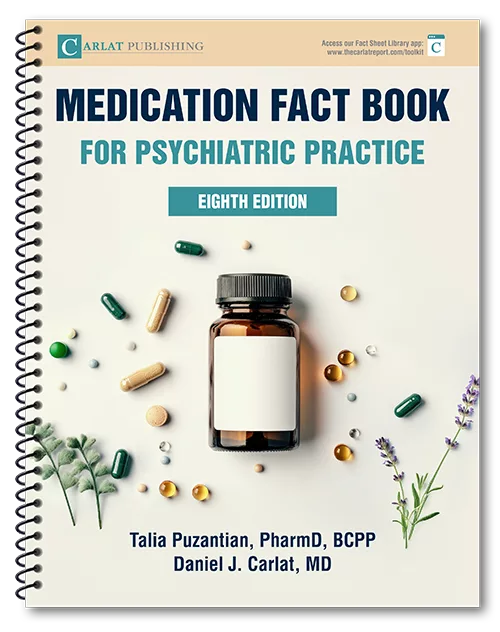Home » Paxil CR: Paxil by any other name...
Paxil CR: Paxil by any other name...
January 1, 2003
From The Carlat Psychiatry Report
Daniel Carlat, MD
Dr. Carlat has disclosed that he has no significant relationships with or financial interests in any commercial companies pertaining to this educational activity.
The latest member of the “controlled-release club” is GlaxoSmithKline, with its Paxil CR. While cynics may believe that CR launches are simply efforts to prolong patent-lives and therefore profits, the reality is that CR formulations are generally better tolerated and easier to dose. This has certainly been the case for the antidepressants Wellbutrin SR and Effexor XR, as well as the multiple extended release stimulant and mood stabilizer preparations.
Now we have Paxil CR, with its “geomatrix” coating, allowing the tablet to pass through the stomach unaltered, so that most absorption occurs in the small intestine, where there are presumably fewer 5HT-3 receptors (the receptors that may be responsible for SSRI-induced nausea.)
Recently, the two pivotal clinical trials (those leading to FDA approval) for Paxil CR in the treatment of depression were reported in a single article in the Journal of Clinical Psychiatry (1). A total of 622 patients were assessed, and were randomly assigned to three groups: Paxil IR, Paxil CR, and placebo. These were 12 week trials (longer than the typical 6 to 8 week antidepressant trial), and at 12 weeks, average doses were: Paxil IR 38.2 mg, and Paxil CR 48.2 mg. The higher dose of CR probably reflects that fact that the geomatrix coating allows only 80% of the total amount of active drug to be absorbed, requiring higher dosages to achieve response. Using the LOCF (last observation carried forward) analysis, only Paxil CR (and not Paxil IR) bested placebo, both in terms of response rate (60% CR vs. 48% Placebo) and remission rates (45% CR, 34% Placebo).
So Paxil CR does work for depression, with response rates in line with typical SSRI depression trials. (The anemic performance of Paxil IR is somewhat concerning, and is not addressed by the authors). Other than this, the only really noteworthy finding was that fewer patients reported nausea during the first week on CR (14%) than IR (23%). However, by week two, there were no significant differences in nausea rates between the formulations. Otherwise, the CR preparation was plagued with all the usual side effects that have earned Paxil the reputation as the “high side effect” SSRI. 27% of Paxil CR patients reported abnormal ejaculation (placebo, 1%), 23% reported somnolence (placebo, 8%), and 19% reported dizziness (placebo, 5%).
One surprising finding was the lack of weight gain on either of the Paxils after 12 weeks. Those who have been following this controversial weight gain issue will remember a Journal of Clinical Psychiatry study in 2000 that showed Paxil causing significantly more weight gain than Zoloft or Prozac over 6 months (2). Perhaps the three months of follow-up for the current study was not long enough to detect weight gain, or perhaps Paxil-induced weight gain has been overblown. (Though I’d guess nine out of ten clinicians are anecdotally convinced that Paxil causes more weight gain than the other SSRIs).
So, what to say of Paxil CR? It’s probably just Paxil, but with a little less nausea for the first 7 days. Will this be enough of an advantage to choose brand name Paxil CR over Paxil IR when it becomes generic and cheaper? Highly doubtful.
TCR VERDICT: Patent ploy?
1. Golden RN, Nemeroff CB, McSorley P. Efficacy and tolerability of controlled-release and immediate-release paroxetine in the treatment of depression. J Clin Psychiatry 2002;63:577-584.
2. Fava M, Judge R, Hoog SL, et. al. Fluoxetine versus Sertraline and Paroxetine in major depressive disorder: Change in weight with long-term treatment. J Clin Psychiatry 2000;61:863-867.
General PsychiatryNow we have Paxil CR, with its “geomatrix” coating, allowing the tablet to pass through the stomach unaltered, so that most absorption occurs in the small intestine, where there are presumably fewer 5HT-3 receptors (the receptors that may be responsible for SSRI-induced nausea.)
Recently, the two pivotal clinical trials (those leading to FDA approval) for Paxil CR in the treatment of depression were reported in a single article in the Journal of Clinical Psychiatry (1). A total of 622 patients were assessed, and were randomly assigned to three groups: Paxil IR, Paxil CR, and placebo. These were 12 week trials (longer than the typical 6 to 8 week antidepressant trial), and at 12 weeks, average doses were: Paxil IR 38.2 mg, and Paxil CR 48.2 mg. The higher dose of CR probably reflects that fact that the geomatrix coating allows only 80% of the total amount of active drug to be absorbed, requiring higher dosages to achieve response. Using the LOCF (last observation carried forward) analysis, only Paxil CR (and not Paxil IR) bested placebo, both in terms of response rate (60% CR vs. 48% Placebo) and remission rates (45% CR, 34% Placebo).
So Paxil CR does work for depression, with response rates in line with typical SSRI depression trials. (The anemic performance of Paxil IR is somewhat concerning, and is not addressed by the authors). Other than this, the only really noteworthy finding was that fewer patients reported nausea during the first week on CR (14%) than IR (23%). However, by week two, there were no significant differences in nausea rates between the formulations. Otherwise, the CR preparation was plagued with all the usual side effects that have earned Paxil the reputation as the “high side effect” SSRI. 27% of Paxil CR patients reported abnormal ejaculation (placebo, 1%), 23% reported somnolence (placebo, 8%), and 19% reported dizziness (placebo, 5%).
One surprising finding was the lack of weight gain on either of the Paxils after 12 weeks. Those who have been following this controversial weight gain issue will remember a Journal of Clinical Psychiatry study in 2000 that showed Paxil causing significantly more weight gain than Zoloft or Prozac over 6 months (2). Perhaps the three months of follow-up for the current study was not long enough to detect weight gain, or perhaps Paxil-induced weight gain has been overblown. (Though I’d guess nine out of ten clinicians are anecdotally convinced that Paxil causes more weight gain than the other SSRIs).
So, what to say of Paxil CR? It’s probably just Paxil, but with a little less nausea for the first 7 days. Will this be enough of an advantage to choose brand name Paxil CR over Paxil IR when it becomes generic and cheaper? Highly doubtful.
TCR VERDICT: Patent ploy?
1. Golden RN, Nemeroff CB, McSorley P. Efficacy and tolerability of controlled-release and immediate-release paroxetine in the treatment of depression. J Clin Psychiatry 2002;63:577-584.
2. Fava M, Judge R, Hoog SL, et. al. Fluoxetine versus Sertraline and Paroxetine in major depressive disorder: Change in weight with long-term treatment. J Clin Psychiatry 2000;61:863-867.

Issue Date: November 1, 2006
Recommended
Newsletters
Please see our Terms and Conditions, Privacy Policy, Subscription Agreement, Use of Cookies, and Hardware/Software Requirements to view our website.
© 2026 Carlat Publishing, LLC and Affiliates, All Rights Reserved.


_-The-Breakthrough-Antipsychotic-That-Could-Change-Everything.webp?t=1729528747)



